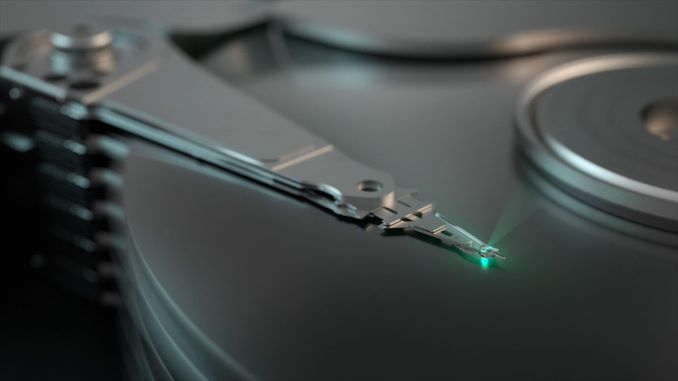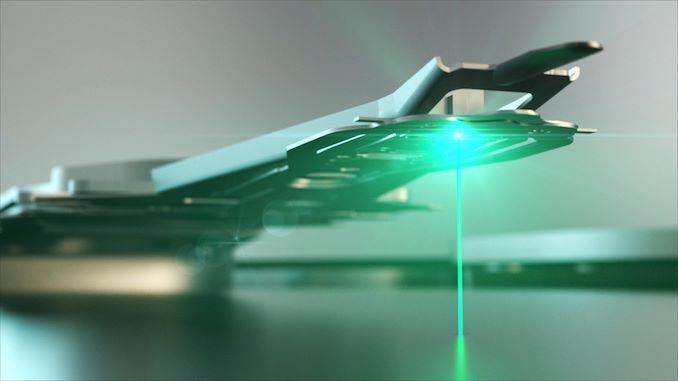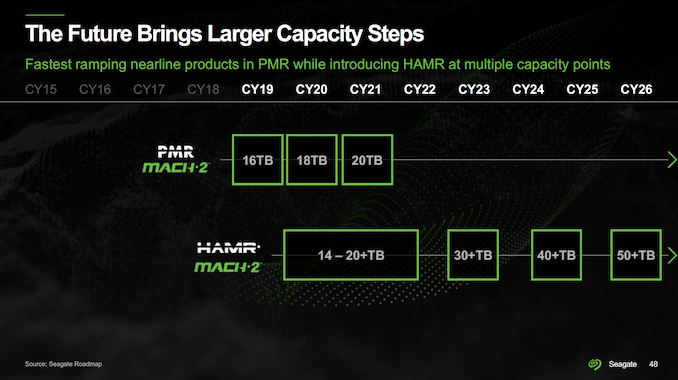Seagate Confirms 30TB+ HAMR HDDs in Q3, Envisions 50TB Drives in a Few Years
by Anton Shilov on January 27, 2023 6:00 PM EST
Seagate this week confirmed plans to launch the industry's first 30+ TB hard drive that uses its heat assisted magnetic recording (HAMR) technology, as well as reaffirming its commitment to release HDDs with capacities of 50 TB and higher in a few years. But before this happens, the company will release 22 TB and 24 TB HDDs that will rely on perpendicular magnetic recording (PMR) and shingled magnetic recording (SMR) technologies, respectively.
One More Play for PMR and SMR
Various energy assisted magnetic recording methods, such as HAMR, will be used for next generations of hard drives for years to come. But while PMR is running out of steam, it is still evolving. Seagate has managed to increase areal density enabled by its PMR + TDMR platform by around 10%, enabling 2.2 TB 3.5-inch HDD platters and thus 22 TB hard drives featuring 10 of such disks. Furthermore, by using shingled recording, these drives can have their capacity stretched to 24 TB.
These 22 TB and 24 TB Seagate Exos drives will likely be drop-in compatible with existing cloud datacenter hardware as well as infrastructure, and should not require extensive validation and certification procedures, unlike brand-new HAMR HDDs. As a result, Seagate's customers will be able to deploy such hard drives fairly quickly and increase storage density and storage capacity of their datacenters.
Seagate is now ramping up production of its 22 TB hard drives for datacenters, so expect the company to start their shipments shortly. Seagate is not disclosing when exactly it will officially launch its 22 TB and 24 TB parts, but we would expect them to arrive before the company introduces its HAMR-based HDDs; so think Q1 or Q2.
30+ TB HDDs Coming in Q3
In fact, Seagate has been shipping HAMR HDDs to select customers for evaluation as well as inside its own Lyve storage systems for a while, but those drives featured capacities akin to those of PMR/CMR HDDs and were not available in huge volumes. With Seagate's 2nd generation HAMR platform, the company is going after higher volumes, but it took the company quite some time to get there. The first pre-qualification high-capacity HAMR-based HDDs are only just now getting ready to head out to customers for evaluation.
"We are meeting or exceeding all product development milestones and reliability metrics, and we will be shipping pre-qualification units to key cloud customers in the coming weeks," said Dave Mosley, chief executive of Seagate.
Meanwhile, commercial HAMR hard drives with capacities of 30TB or higher will ship in third quarter of this year, which is in-line with what Seagate promised last year.
"As a result of this progress, we now expect to launch our 30-plus terabyte platform in the June quarter, slightly ahead of schedule," said Mosley. "The speed of the initial HAMR volume ramp will depend on a number of factors, including product yields and customer qualification timelines."
Initially Seagate will only offer its HAMR technology for its highest-capacity offerings for hyperscale datacenters, whom need maximum storage density and are willing to pay premium for the drives and for supporting infrastructure. As yields of HAMR-supporting media and the appropriate read/write heads increase, the technology will be applied for drives with lower capacities in a bid to cut down their production costs (fewer disks and heads, lower the costs). This is not going to happen overnight though, as the company needs to increase yields of HAMR drive components and the HDDs themselves to a comfortable level.
"I think this year, [the volume of HAMR HDDs] will probably still be relatively low," said the head of Seagate. "Then the faster we can get the yields and scrap and all the costs that we can control down on the heads and media, then the faster we'll be accelerating. I think that will happen in calendar year 2024 and calendar year 2025 will just continue to accelerate. The highest capacity points will be addressed, but also these midrange capacity points."
50+ TB HDDs Will Be Here in a Few Years
Seagate's launch of its first mass market 30+ TB HAMR hard drives platform will mark a milestone for the company and the whole industry. But apparently the company has another breakthrough to share at this time. The firm said this week that it had created 5 TB platters for 3.5-inch hard drives, which presumably entails new media, new write heads, and new read heads.
"It was nearly four years ago to the day that I first shared our lab results demonstrating 3 TB per disk capacities," explained Mosley. "And today, we have demonstrated capacities of 5 TB per disk in our recording physics labs."
For now, these platters are used on spinstands for evaluation and testing purposes, but platters like these will allow for 50 TB HDDs a few years down the line. Seagate's roadmap indicates that such hard drives will hit the market sometimes in calendar 2026.
It is unclear how thin the new platters are. But following current trends of nearline HDD evolution — increasing areal density and increasing number of platters per hard drive — it's not outside the realm of possibility that Seagate will find ways to integrate even more than 10 platters in future drives. In which case Seagate would be able to hit drive sizes even larger than 50 TB.
In any case, with ~3 TB platters in production, samples of ~30 TB HDDs shipping to customers, and 5 TB platters demonstrated in the lab, Seagate's HAMR roadmap seems to look quite solid. Therefore, expect hard drives to gain capacities rapidly in the coming years.












70 Comments
View All Comments
hansmuff - Tuesday, January 31, 2023 - link
Aah, tape. When I was a teenager, TRAVAN tapes and QIC-80 actually were being sold in high volume to end-users, not just IT. I had a tape drive. Sure, slow as all shit but the tapes were indestructible compared to a CD or another HDD.I'd still have tape if I had more backup needs, but modern LTO drives are a little costly to me.
Samus - Wednesday, February 1, 2023 - link
I recently recovered data from a set of DDS-2 tapes I found at my parents. Data was archived using Win95 backup so I had to build a friggin Win95 PC out of a P3 I bought and source a DAT drive (the first DDS-2 drive off eBay wouldn't read the tapes and turned out to be a defective drive, when I thought the tapes were the problem, but a second HP StorageWorks DDS-4 drive had DDS-2/3 R/W compatibility.)Anyway, all 4 tapes recovered perfectly with no errors. They were stored in a basement that wasn't humidity or temperature controlled here in Chicago for over 25 years. That says everything you need to know about why tape media and magnetic storage in general are the archive standard bearer.
thunderbird32 - Wednesday, February 1, 2023 - link
Depends on how "long term" you want it to be. Lots of QIC tapes from the 90's and back are no longer usable because the rubber bands have turned to goo. Hopefully more "modern" tape designs like LTO have better shelf life.Samus - Thursday, February 2, 2023 - link
QIC (and Travan) were a race-to-the-bottom storage medium for cost-conscious consumers. Iomega and Seagate pushed them hard and there was unfortunately adoption. They were garbage back then and they're even less than garbage now.DAT and LTO have by design simple and robust storage vessels. The tape media itself is incredibly high tech, having gone through many material changes but all of which have guaranteed a minimum archival lifetime of many, many decades when stored in a dry cool environment.
I have a softspot for DAT because of its incredible flexibility and reasonable cost of entry, more than QIC but much less than LTO. Working in IT for decades, we had used DDS entirely through the 90's and 00's until it was abandoned. These days only one office I manage has tape backup and it is unsurprisingly LTO. Reliable cloud backup options and inexpensive JBOD's for on-site backup have mostly replaced the need for SMB tape backup but you are still presented with the security risk of live backup storage. LTO auto loaders are truly the most secure on-site backup option if you can afford it.
UltraTech79 - Monday, January 30, 2023 - link
lol They arnt. Where are you getting your bs "pretty sure" from? Cherry picking?TheinsanegamerN - Tuesday, January 31, 2023 - link
Cold storage rating. NAND memory is measured in weeks, magnetic platters in years.Threska - Friday, January 27, 2023 - link
Gotta keep up as backups for other hard drives, and them for other drives.Doug_S - Saturday, January 28, 2023 - link
Adding the HAMR component may increase cost but the economics for hard drives are different today than they were a decade ago when they were still shipped with almost every laptop and PC. Back then they wanted drives with a single platter to cost as little as possible, with $/GB a secondary concern at best, which limited the amount of technology that could be employed.Now that hard drives are bulk storage only they are concerned about the $/GB figure, with total concern of secondary concern. So they can add more expensive technology to the functional part of the drive if means enough additional bytes stored that $/GB is less even when total cost is more. Because as you say if SSDs can close the gap for cost per capacity then it is game over for hard drives.
As to your second paragraph, I would assume they haven't mentioned a limit on "program/erase" cycles since like other hard drives they are unlimited.
LiKenun - Sunday, January 29, 2023 - link
At some point, hard disks will *only* be good for cold storage.A 3.5″ drive occupies a volume of 18.1 cu in. A 2.5″ drive occupies a volume of 6.5 cu in. The highest capacity hard disk drive will be 30 TB, giving a density of 1.7 TB per cu in. The highest capacity 15 mm, 2.5″ solid state drive will be 61 TB (announced by Solidigm in November 2022) giving a density of 9.6 TB per cu in. To break even with such a density, a 3.5″ hard disk drive would need to have a capacity of 174 TB. In other news, Nimbus Data announced back in April 2022 that they were working on a 200 TB 3.5″ solid state drive, bringing the density to 11.0 TB per cu in.
Hard disk drives had already lost the capacity crown since the 8 TB 2.5″ solid state drives came out in 2016. Now we’re just waiting for the cost of NAND to encroach into one of hard disk storage’s last advantages over it.
Doug_S - Monday, January 30, 2023 - link
TB/cu inch is not a metric anyone cares about